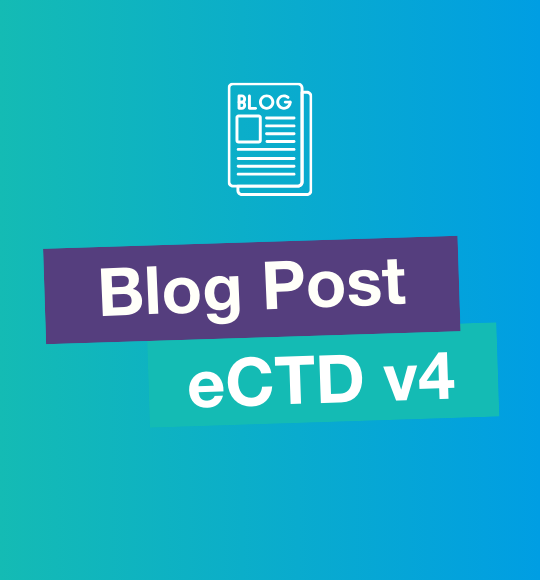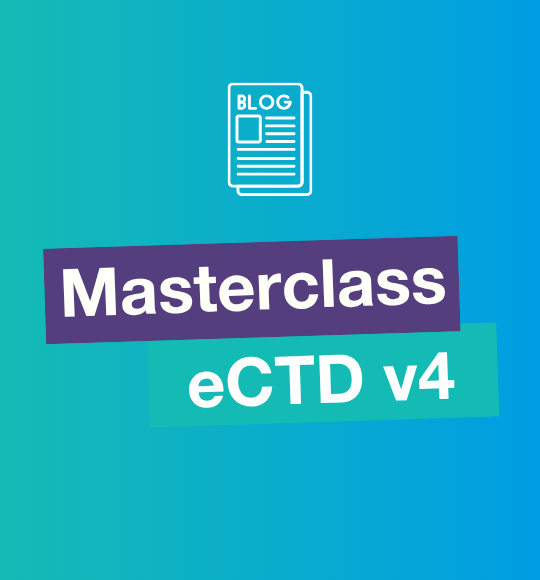.png?width=576&height=265&name=Blog%20Post%20Banner%20_%20ISO%20IEC%2027001%20(4).png)
eCTD v4 - A Global Overview
The move to eCTD v4 is no longer a theoretical evolution - it is an active, phased global rollout. Regulators and life science organizations are now navigating technical pilots, voluntary initial applications in eCTD v4 format, as well as planning for the various regional deadlines agreed at the ICH level.
The Impact: The shift to eCTD v4 is not just a technical upgrade - it’s an organizational transformation that touches regulatory, clinical, safety, medical writing, QA, IT, legal, and commercial teams. Organizations that treat it as a change-management program, with clear governance, executive sponsorship, cross-functional working groups, phased pilots, and targeted training, will capture efficiency gains and a strategic advantage.
What does eCTD v4 actually deliver?
- A combination of documents and connected data: richer machine-readable metadata, better described documents by keywords, and more granular lifecycle management.
- Better automation, improved reviewer tooling, easier reuse of content, and accelerated patient access through data-driven reviews and streamlined cross-region filings.
Where do regulators stand with eCTD v4 timelines?
Worldwide adoption of eCTD v4 offers a valuable phased approach: jurisdiction‑by‑jurisdiction rollouts let sponsors and regulators pilot, learn, and refine practices so implementations are smoother, better aligned, and more scalable globally. The current state is that some authorities have already completed initial rollouts, others are running pilots or offering voluntary windows, and several have set mandatory enforcement dates that extend into the next decade. Here is a narrative summary of where the major regulators stand and what to expect.
.png?width=2283&height=1063&name=ICH%20Overview%20eCTD%20V4%20Timelines%20-%20October%20%20(1).png)
Figure 1: eCTD v4 timelines published on the ICH webpage (07/2025)
- Japan’s MHLW/PMDA moved early: the initial rollout was completed in the second quarter of 2021, with a voluntary phase in 2022 and a mandatory requirement established for 2026. Sponsors with Japanese filings should already be well into or completed with their eCTD v4 readiness for mandatory compliance.
- Across Europe, the rollout is phased by procedure type. The European Commission kicked off CAPs (centralised authorisation procedures) pilots in 2024 and is progressing through staged voluntary windows: expanded voluntary acceptance in 2025 for additional CAPs and voluntary adoption for MRP/DCP/NP procedures in 2026. CAPs are slated to become mandatory in 2027, while the mandatory date for MRP/DCP/NP remains to be confirmed, so pan‑European filers need procedure‑specific readiness plans.
- The United States FDA completed its initial rollout between 2022 and the second quarter of 2023, offered a voluntary phase in 2024, and has set a mandatory compliance date of 2029. This trajectory gives sponsors a multi‑year window to convert workflows and legacy content ahead of the mandatory deadline.
- Health Canada is planning implementation activity in 2026 - 2027, with a voluntary acceptance period beginning in 2027 and a mandatory requirement targeted for 2029. Canadian filers should use the 2026–2027 lead‑up to pilot approaches and align with the later mandatory enforcement.
- Swissmedic anticipates beginning implementation activity in 2026, with a voluntary period in 2027 and a mandatory enforcement date in 2030. This gives Swiss filers a longer runway to switch to eCTD v4 while still requiring planning for the 2026–2027 voluntary window.
- The Republic of Korea’s MFDS has not published a firm start date for eCTD v4 activity, but has indicated a voluntary window in 2027; the mandatory timeline has not yet been determined. Korean submissions will therefore require close monitoring of MFDS updates for the eventual mandatory date.
- In Brazil, ANVISA has planned activity beginning in the fourth quarter of 2026, with a voluntary acceptance period expected in 2027. The agency has not yet announced a mandatory enforcement date, so sponsors should plan for voluntary engagement first and watch for the mandatory timeline to be confirmed.
- Australia’s TGA plans implementation work in 2026 and expects a voluntary acceptance phase in 2027; it has not yet announced a mandatory date. The TGA’s schedule aligns with the broader 2026 - 2027 inflection period seen across many regulators.
Taken together, the global picture shows a concentrated wave of pilots and voluntary windows around 2026 - 2027, followed by staggered mandatory deadlines that range from 2026 (Japan) through 2030 (Swissmedic) and beyond for authorities that have not yet set firm mandatory dates. Organizations should treat 2026 - 2027 as a critical inflection window for pilots and scale‑up while tracking individual agency updates for final mandatory timelines.
While eCTD v4 brings a harmonized technical foundation, practical implementation will look different from region to region. Sponsors should plan for commonality where it exists, but also build flexibility to meet jurisdictional business rules, validation behavior, and operational workflows.
What may differ in practice?
For example, controlled vocabularies and code lists: expect agency‑specific terminologies for things like document types, lifecycle actions, and regulatory procedures.
Validation rulesets: the severity of validation errors and the required remediation path can vary - some agencies will block submissions for certain errors; others will allow acceptance under voluntary phases.
What do all have in common?
Across jurisdictions, the move to eCTD v4 shares a consistent technical and operational foundation - even though timing, business rules, and portal behaviors differ.
They all need new operational workflows: structured authoring, metadata governance, content reuse strategies, and conversion/migration of legacy dossiers are common organizational tasks everywhere.
Rich metadata and controlled vocabularies are globally in common: agencies require structured metadata to identify document types, lifecycle actions, regulatory procedures, and other key attributes - often with localized code lists layered on top.
The use of a viewing tool is also common for all eCTD v4 submissions.
Why is a viewing tool essential for eCTD v4?
With componentized, metadata-rich submissions, a reviewer cannot rely on simple PDF viewers or zip-file listings. Both sponsors and regulators need a dedicated eCTD v4 viewer to reliably render structured content, expose metadata and lifecycle actions, and support modern review workflows. A proper viewing tool becomes the single pane for authors, QC teams, and reviewers since the eCTD v4 submission unit is not human-readable and the documents are added in stored in a flat hierarchy.
EXTEDO’s eSUBmanager is ready for regulators and reviewers alike: a secure, user-friendly viewer for the next generation of eCTD.
The next 24–36 months are pivotal. If your organization has not already started, set a concrete project plan now: inventory submissions, pilot componentized authoring, choose tools that support ICH eCTD v4, and engage with regional regulators or industry pilots. Track the timelines above as living targets; they may evolve, and prioritize readiness for the 2026–2027 window, where many jurisdictions will move from planning to voluntary acceptance.
.png)


